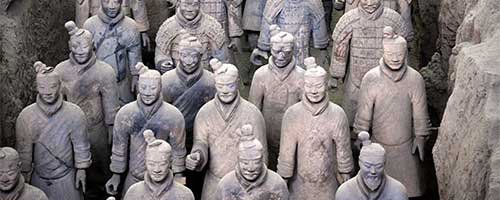Terracotta Army Excavation
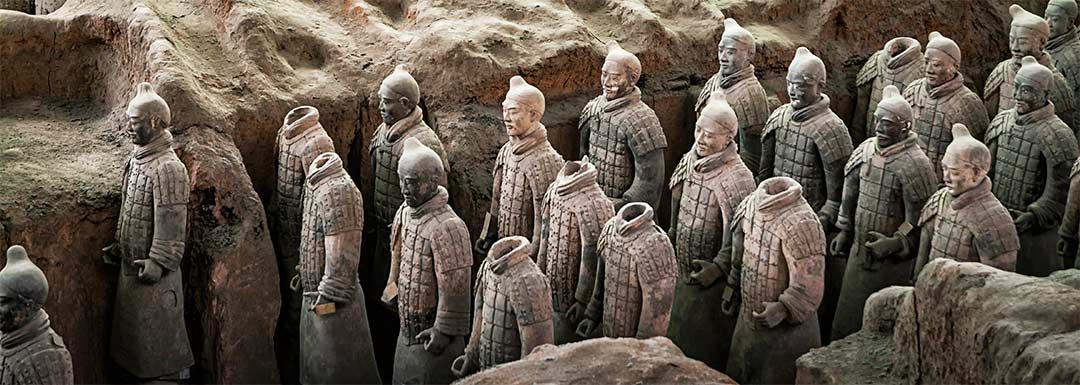
From 1974 to 1977, the Pits of the Terracotta Warriors, which serve as funerary pits for the mausoleum, were excavated at a location 1km away from the Mausoleum of the First Qin Emperor. The No.1 Pit is located in the south, with a length of 216m from east to west, a width of 62m, and an area of 13,260m2. The No.2 Pit has a length of 124m from east to west, a width of 98m, and an area of 6,000m2. The area of the No.3 Pit is 520m2. A total of 800 warrior figures were unearthed along with 18 wooden chariots and more than 100 pottery horses. Based on the existing arrangement patterns, it can be inferred that there might be a total of 7,000 warrior figures, 100 chariots, and 100 war horses. The warriors appear very tall, usually with a height of 1.8m.
Excavation Time of No.1 Pit and Unearthed Relics
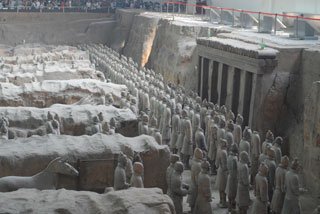 No.1 Pit of Terracotta Army
No.1 Pit of Terracotta Army
The No.1 Pit was the first of the three warrior figure pits to be discovered. In February, 1974, local farmers were digging a well 1.5km from the eastern side of the Mausoleum of the First Qin Emperor, and they discovered the life-size terracotta warriors and horses quite by accident. Since then, an underground army which has remained buried for over two thousand years has been unearthed, and a museum was built at the site.
Excavation from 1974 to 1984 and the Unearthed Relics
From 1978 to 1984, the Qin Figure Archaeological Team of Shaanxi Provincial Archaeological Research Institute excavated the No.1 Pit. The excavation area was 2,000m2. The team unearthed 1,087 terracotta figures, some of which were then repaired and restored.
Excavation in 1985
In 1985, the archaeological team conducted the second excavation at the No.1 Pit, and the excavation area was 2,000m2. Unfortunately, given the imperfect technologies and equipment, the second excavation was suspended just one year after its initiation for better protection of the relics. And the excavation did not unearth many valuable relics.
Excavation in 2009 and the Unearthed Relics
On June 13, 2009, the third excavation of the No.1 Pit of Qin Warrior Figures began, with an excavation area of 200m2. Up to now, this round of excavation in the No.1 Pit has unearthed 114 figures in total. The warriors showed vivid facial expressions and postures, various types of appearances, with different features for their costumes, hairstyles and weapons. However, the warrior figures in the No.1 Pit were a bit too tall, ranging from 1.8m to 2m, which made conservation difficult, and they were all damaged. The figures unearthed include 28 armored footman figures lined up in 6 rows and 6 chariot officer figures in two groups. The warrior figures unearthed this time showed obvious burning stains. They might have been burnt by the rebels of the peasant uprisings in the late years of Qin Dynasty.
Excavation Time of No.2 Pit and the Unearthed Relics
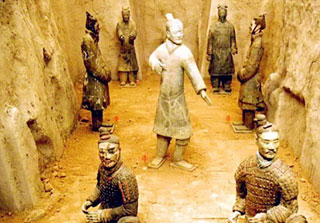 No.2 Pit of Terracotta Army
No.2 Pit of Terracotta Army
The No.2 Pit displays the most spectacular military phalanx among the three pits. The pit exhibits a special army consisting of multiple forces, including cavalry, chariots and infantry (including crossbowmen), etc. These warrior figures also show burning stains.
Excavation in 1976
From April to May in 1976, during the excavation work at the north side of the east end of the No.1 Pit, the archaeological team discovered another pit with terracotta warriors and horses, and it was named as the No.2 Pit of the Terracotta Warriors. This is not a round of dedicated excavation for the No.2 Pit in particular. Instead, the No.2 Pit was discovered by accident when the team was excavating the No.1 Pit. Given that the excavation of the No.1 Pit is still ongoing, the No.2 Pit has not been intensively excavated.
Excavation in 1994
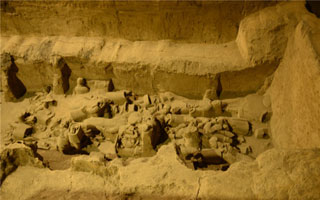 Broken Terracotta Warriors in Pit No.2
Broken Terracotta Warriors in Pit No.2
During this excavation, over the pit, the archaeologists found pine logs with a length of 4 to 8m and a diameter of 30 to 65cm. These logs formed the ceiling of the pit. Above the pine logs, there was a layer of reed mats, which were covered with soil. If the team continued to dig, they might possibly damage the relics, so they directly penetrated the pine logs and removed the earth, and they stopped their excavation as soon as they saw the relics. The No.2 Pit contains cavalier figures, kneeling and standing archer figures, which do not exist in No.1 Pit. The kneeling archers were considered the “luckiest figures”, because they were basically intact when they were unearthed. The standing figures range in height from 1.75m to 1.96m. Their center of gravity is at their butt. If there is a little shaking, they would easily fall and break into pieces. The kneeling archers are 1.2m to 1.3m tall. When they fall, they would lie on their side, and it is not easy for them to break into pieces.
Excavation that Began in 2015
In 2015, archaeologists began the second massive excavation in the No.2 Pit. The excavation is currently ongoing, and there have been no official releases about new discoveries. However, there are two expectations for the relics that might be unearthed in the No.2 Pit.
1. Is it possible there are figures of foreign mercenaries?
In 2003, archaeologists found an ancient tomb near the No.2 Pit. In the tomb, among 121 buried skeletons, there were some with western characteristics. Therefore, it is not unreasonable to expect that figures of western mercenaries would be unearthed.
2. Is it possible that there are Qin weapons that were previously unseen?
The No.2 Pit accommodates the most diverse troops. Many experts have inferred that it might include new weapons.
Excavation Time for No.3 Pit and Unearthed Relics
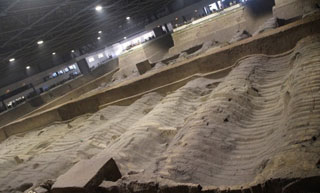 Command Center Still covered by soil
Command Center Still covered by soil
Like No.2 Pit, No.3 Pit was also discovered by accident when the No.1 Pit was being excavated. It was discovered on May 11, 1976. Currently, no dedicated excavation work is being undertaken for No.3 Pit specifically. The area of No.3 Pit is only 1/25 of the No.1 Pit, which is the largest. The armor on the 68 unearthed warrior figures appear with brighter colors than those of the No.1 and No.2 pits. As a result, experts infer that No.3 Pit is probably a command center, and the figures are all military officers rather than ordinary soldiers. It is noticeable that No.3 Pit is the only one that has not suffered burnings.
Drop us a line and we'll connect you with the top China expert in no time!
